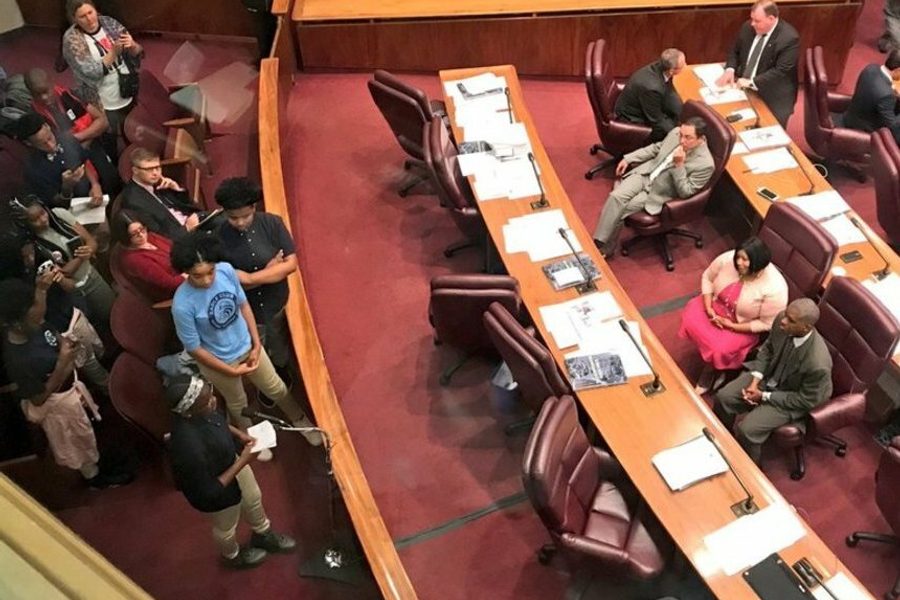INVESTIGATION: The Troubled History of the Fund Tapped for Rahm’s Controversial Cop Academy
$20 million in West Side TIF money for job creation has sat unspent, and another $36 million was “ported” to other districts. Now more than $10 million is being used for a police academy that will create only 100 temporary jobs.
Rebecca Burns

The city of Chicago has officially closed the deal on the purchase of a 30-acre lot for a controversial new police and firefighter training academy.
In November, the City Council approved a $9.6 million acquisition of vacant land in the Garfield Park neighborhood. The council overrode the wishes of dozens of police accountability, education and economic justice advocates — even joined by Grammy-winning Chicago artist Chance the Rapper — who presented hours of testimony opposing the project.
Public outcry is motivated in part by suspicion that Mayor Rahm Emanuel’s proposal for a state-of-the-art training facility, with total costs estimated at $95 million, is intended to deflect attention from deeper police accountability reforms advocated by community activists — as well as by the Department of Justice (DOJ) in a scathing January 2017 report.
“I don’t know of a single study that says that if you pour some new cement, put up some new windows and give the cops a swimming pool, they’re going to stop shooting black and brown people,” said Alderman Carlos Ramirez-Rosa, the lone dissenting vote, at a press conference by groups opposed to the project prior to the November vote.
Emanuel maintains that the new academy is necessary to address the DOJ’s training recommendations, but proponents are also billing the project as a much-needed economic stimulus for the city’s struggling West Side.
“We often said, ‘When are we going to get that economic boost over here on the West Side?’, Now you got it,” said Alderman Emma Mitts (37th), whose ward includes the new academy, when the plan was unveiled in July 2017.
The city estimates that the project will create about 100 temporary construction jobs, but it’s not otherwise clear how the training facility would benefit the neighborhood economically.
The claim that the police academy is a singular opportunity to promote development on the West Side is also a strange one in light of the fact that the city has for years failed to spend millions of dollars earmarked for just this purpose.
An In These Times investigation has found that more than $20 million has been sitting unspent in an account meant to promote investment in the Tax Increment Financing (TIF) district where the academy is slated to be built, known as the Northwest Industrial Corridor. Another $36 million has been “ported” to other districts. That means that of nearly $82 million set aside from property taxes for development, only $25 million has actually been spent on the Northwest Industrial Corridor. Now, the city wants to use nearly half of the remaining funds — $10.8 million — for the police academy.
In this context, the police academy deal adds insult to injury for the residents of West Side neighborhoods who have struggled to redirect resources to schools, affordable housing, healthcare and good jobs available to neighborhood residents.
“This shows what type of things and people Rahm truly cares about,” says Yolanda J (who declined to use her full name), a 15-year-old resident of North Lawndale who is organizing opposition to the project as part of the #NoCopAcademy coalition. “The city’s priorities are all messed up.”
The T on TIFs
TIF is a public funding tool that redirects property tax dollars in a given “TIF district” to special projects in the same district. In turn, TIF projects are supposed to spur economic development in blighted areas (and eventually pay for themselves through increased property tax revenue). While this principle remains largely unproven, Chicago’s use of TIF has exploded since the 1990s. The city now has 145 TIF districts, encompassing one out of every four total Chicago properties, that collected $561 million in tax revenue last year. Many districts are sitting on huge surpluses of unspent funds. According to the TIF Illumination Project, there was more than $1.4 billion sitting in Chicago’s TIF accounts as of January 2017. Property taxes diverted into TIF accounts would otherwise have gone to the cash-strapped Cook County, Chicago’s public schools, parks and other public services, though a complicated tax formula makes it difficult to determine exactly how much is lost to TIFs.
While TIF is purportedly an economic development tool for poorer neighborhoods, analyses of city records have shown that what spending does happen occurs largely in already wealthy neighborhoods: Nearly half of the $1.3 billion in tax increment financing funds allocated from 2011 to 2015 went to the Loop and surrounding areas. That’s led scholars, public officials and community activists alike to question whether TIF truly promotes economic development, and for whom.
When money is spent, it’s often with little oversight. A partial audit of spending in the Central West and the Central Loop TIF districts by the Chicago inspector general in 2010 concluded that “internal controls were not adequate to ensure effective management of the TIF expenditures.” The report cited, among other concerns, “deceptive billing practices” and $90,000 of “questionable and unauthorized expenses” during the TIF-financed renovation of the existing Chicago police academy, which city officials now say is too outdated to use.
In a report released last year, Cook County Clerk David Orr called for TIF reforms, including a full review of funds, noting that nearly 10 percent of property tax revenue billed within the city of Chicago is now diverted into TIF accounts.
A giant sucking sound
To put TIF spending on the police academy project into context, In These Times reviewed the history of expenditures in the Northwest Industrial Corridor. Redevelopment agreements for the handful of projects approved in the district show that the company selling the land, whose owners donated $10,000 to Rahm Emanuel’s last campaign, will receive the largest TIF payment to date in the Northwest Industrial Corridor.
Since its establishment in 1998, the Northwest Industrial Corridor TIF has collected more than $80 million in property taxes. The original redevelopment plan from 1998 notes the loss of thousands of jobs in the area after Schwinn, Playskool and other plants closed their doors during the past 40 years. By improving roads and other infrastructure, clearing vacant land for re-use and recruiting new businesses, planners hoped to “reestablish the area as a modern industrial center,” thereby expanding the tax base and boosting employment in surrounding residential areas. A table of estimated redevelopment costs lays out $181 million (in today’s dollars) in total spending, including $61 million for purchase and rehabilitation of vacant land and $18.3 million on job training.
Instead, a review of the district’s expenditures from 2001 – 2016 shows just $25 million in spending. $1.9 million was spent on land acquisition and preparation, while $13 million was spent on “public improvements,” a broad category that includes payments to the parks and transportation departments, as well as to private companies. $2.7 million spent on job training initiatives was shared between more than 10 small employers and non-profits. At least $1.3 million was paid out to a single developer for construction of a new Coca-Cola distribution facility that reportedly employed only 28 local residents in 2009, out of 244 employees, according to a 2011 investigation by the website AustinTalks, a project of Columbia College Chicago’s journalism program. (The Coca-Cola did not respond by press time to a request for the latest employment figures at the facility.)
The city has not disclosed in its annual reports how many jobs have been created by TIF expenditures in the Northwest Industrial Corridor or how much the property tax base has expanded.
At the end of the 2016 fiscal year, the Northwest Industrial Corridor was still sitting on more than $20 million of unspent funds, according to the most recent annual report available. The city’s funding projections show that $10.8 million has been reserved for the land purchase in the 2017 fiscal year. This amount is greater than the $9.6 million approved by the City Council, with the overrun “largely allocated toward site prep, environmental review, and related costs,” according to a spokesperson for the city’s Department of Planning and Development.
An additional $36 million in collected property taxes was actually been transferred out of the district through an obscure process known as “porting.”
From 2004 – 2016, $28 million was ported from the Northwest Industrial Corridor TIF into neighboring districts. This funding was used to pay down the debt on bonds issued to finance new school construction under former Mayor Daley’s $1 billion initiative to build 24 new schools and renovate three others, part of the Renaissance 2010 plan announced in 2006 as an election approached.
While many community activists have called for TIF surpluses to be reallocated to Chicago Public Schools (CPS), TIF-financed school-building boom is controversial because it does not allocate resources for anything other than the physical buildings, and the spending appears to deepen existing inequalities. A 2012 report by Roosevelt sociologist Stephanie Farmer found that 24 percent of TIF dollars spent on CPS projects went to selective enrollment schools, which make up just 1 percent of CPS.
Critics of the police academy see a troubling connection between the use of TIF dollars to promote charter schools, which punish and expel black students at higher rates than neighborhood schools, and the use of TIF dollars for a police training academy that activists say will further alienate and endanger black and brown youth.
Development, for whom?
This isn’t the first time that West Side neighborhoods have clashed with the city over its definition of “development.” In 2008, the city proposed a $10 million TIF subsidy for a new warehouse and distribution center at the former site of Brach’s candy factory. Once a key local employer, the candy-corn maker closed its doors in 2003 after shipping more than 1,000 jobs overseas, and the building had sat unused since then — save for when director Christopher Nolan blew up part of the factory for a scene in the 2008 Batman movie Dark Knight, a usage that carried a painful symbolism for residents watching their neighborhood decline.
But community activists wanted the site for another purpose. The city had closed Austin High School in 2007, leaving the neighborhood without a traditional public high school that could serve some 3,000 students in the neighborhood. Angry that their children now had to travel to other neighborhoods, the Austin Community Education Network began drafting plans for a new, state-of-the art high school with a green technology center and athletic facilities. Education activists identified the 30-acre candy factory lot as an ideal site for the new school campus – far superior to a smaller, less central location that CPS was proposing for a new neighborhood school. Extensive community planning processes, with assistance from pro bono lawyers and architects, yielded a detailed plan that won support from an anonymous donor, who agreed to pay $5,000 to acquire the land, and State Representative LaShawn Ford, who promised to fight for state funding for the project.
“We really thought that if we raised the money, we would have a shot,” says Jacqueline Reed, founder and past president of the Westside Health Authority, who helped lead rallies and delegations to City Hall where neighborhood residents testified in supporting of reserving the land for a new school. “It would have promoted economic development by bringing a lot of middle-class families back to the community, if there were good schools.”
But 28th Ward Alderman Ed Smith had already backed the warehouse plan — despite the fact that it came with no guarantees of new jobs or local hiring. In June 2008, the City Council voted in favor of awarding the $10 million subsidy to a developer that was already building a new Coca-Cola distribution facility in the neighborhood with TIF dollars.
Worse, the plan faltered in the midst of the financial crisis, and the city eventually terminated the agreement. “The land is still sitting there, and our children still need a school in Austin,” says Reed.
Reed says she supports the idea behind TIF, and her organization has had some positive experience with the program. The Austin-based nonprofit, which offers health, employment and other services to low-income residents, received TIF dollars to open up a wellness center in 2004, which stands less than a mile from the future site of the public safety training facility. But “it’s too easy to mis-use [TIF] for pet projects,” says Reed.
Will the new public-safety training academy yield a better income? The project is now in the hands of the Chicago Infrastructure Trust, the body dedicated to spearheading private-public partnerships. According to a recent Chicago Sun-Times investigation, the trust has cost taxpayers $5 million while “fail[ing] to raise a dime of private money” since Emanuel announced its creation in 2012. Many questions remain, including how exactly the remaining costs of the training facility will be financed — the infrastructure trust’s documents say that the city will tap into its capital funding program, and could also consider a lease-to-own plan — and whether the facility will truly promote economic development in the neighborhood.
Either way, for Reed, there’s an enormous opportunity cost. “I haven’t found one person outside of politicians who really think that the police academy is really a good way for us to improve our community,” she says. “People feel that we need to have more of an investment for our children, more opportunities and less reliance on police. The police will never be able to solve all our problems.”
This story was supported by the Leonard C. Goodman Center for Investigative Journalism as part of the National TIF Illumination Project.
Rebecca Burns is In These Times’ housing editor and an award-winning investigative reporter. Her work has appeared in Business Insider, the Chicago Reader, the Intercept, ProPublica Illinois and other outlets.








